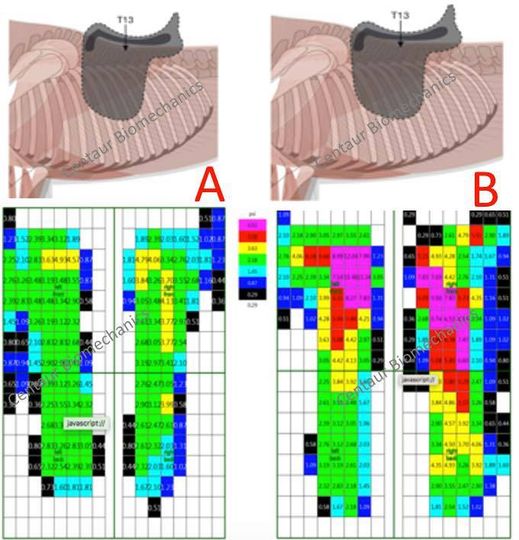
This is a question which has been raised multiple times. Some of the thoughts which underpin the idea that fitting a saddle “wider” than industry guidelines are; “allows the horse to work over the back better”, “allows the horse to lift up”, “allows muscle activation” and “won’t restrict scapula mechanics” just to list a few. Although at first glance this may seem logical, fitting a saddle wider, allowing the region of the back beneath to have more room, there is no experimental evidence to support this approach.
In the static horse, a wide saddle will have the appearance that the front of the saddle is down when compared to the back of the saddle (image B.). When applying pressure with your hand to the front of the saddle, the back will lift up. In the dynamic horse, the position and orientation of the saddle remains the same (down at the front), plus we add the mass of the rider. Previously we have demonstrated the effect that a “wide” saddle has on back movement, muscle dimensions, locomotion and rider position when compared to a “correctly” fitted saddle (1, 3, 4). During trot and canter when ridden in a wide saddle, the back showed altered range of motion, which is likely as a result of the saddle instability (down at the front, up at the back). As a function of the front of the saddle being down during locomotion, this resulted in areas of high pressures in the front region of the saddle (left and right, image B. ), the magnitude of pressure and locations were consistent across all horses with peak pressures being directly influenced by limb movement. To emphasise the effect that tree width has on the locomotor apparatus of the horse, after twenty minutes of exercise in a wide saddle, compressions (concavities) in the epaxial musculature in the region of T13 were recorded (1, 3, 4). These compressions are as a result of the high pressures which occurred as a function of saddle width (down at the front). Horses develop compensatory strategies to alleviate any discomfort caused, in this case by the saddle width. In a wide saddle, every motion cycle, the horse will experience high pressures in the front region of the saddle, and of course will alter its locomotion to compensate.
The idea that fitting a saddle wider than industry guidelines is a fallacy. In contrast to the anecdotal beliefs, it could have deleterious effect on the horse’s locomotor apparatus. It is assumed that if the horse has more room, it will be able to utilise that space by altering its biomechanics. However, the dynamic forces from the rider must be considered, in the case of the wide saddle which is down at the front when the horse is stood square (no rider), then adding the mass of the rider, combined with the locomotor forces, the saddle will remain and increase its pitch in a forward / downward direction – comprising the horses locomotor function. The wide saddle will also affect the rider biomechanics which will be addressed in part 2.
The results outlined here are in accordance with researchers in Europe (2) where a group of horses were ridden on a treadmill with saddles of varying widths. It is appreciated that the saddle width can be corrected with a half pad/front riser. This strategy may be of benefit however, we must consider the half pad/front riser being used, in respect that the pad must be able to manage the dynamic forces and not deform under load, as the saddle which is “in balance” with a half pad/front riser , which then deforms during locomotion will become “out of balance” wide. From preliminary data, saddles which were wide but rebalanced to correct width with the use of a front riser, after twenty minutes of exercise, the concavities at T13 were still apparent (sadly, COVID has prevented pressure data collection). Therefore, although the saddle is “in balance” we must be cautious that it doesn’t become out of balance during locomotion. There are situations where a half pad/front riser can used to help rebalance saddles, in these cases it is essential that horse owners work closely with their qualified saddle fitter with regular checks in order to monitor any changes and rebalance saddles accordingly.
*NB: correct width defined as: The shape of the head of the tree and the angle of the tree points corresponding to the shape and angle of the horse 5cm behind the scapulae.
Please like / follow our page for more blogs and please share to raise awareness.
Dr. Russell MacKechnie-Guire
Centaur Biomechanics
www.centaurbiomechanics.co.uk
#equineresearch #biomechanics #centaurbiomechanics #veterinarymedicine #equinephysiotherapy #equinetherapist #onlinecourses #onlineseminar
1. MacKechnie-Guire R, MacKechnie-Guire E, Fairfax V, Fisher D, Fisher M, Pfau T. The Effect of Tree Width on Thoracolumbar and Limb Kinematics, Saddle Pressure Distribution, and Thoracolumbar Dimensions in Sports Horses in Trot and Canter. Animals (Basel). 2019;9(10).
2. Meschan EM, Peham C, Schobesberger H, Licka TF. The influence of the width of the saddle tree on the forces and the pressure distribution under the saddle. Vet J. 2007;173(3):578-84.
3. R. MacKechnie-Guire, E. MacKechnie-Guire, V. Fairfax, D. Fisher, M. Fisher and T. Pfau. (2019), Kinematics of the thoracolumbar spine whilst cantering in horses fitted with a saddle of three different widths, BEVA Congress, EVJ Supplement, https://onlinelibrary.wiley.com/.../10.1111/evj.13_13152...
4. R. MacKechnie-Guire, E. MacKechnie-Guire, V. Fairfax, D. Fisher, M. Fisher and T. Pfau. (2019), Can saddle tree width affect saddle pressure distribution whilst cantering?, BEVA Congress, EVJ Supplement, https://onlinelibrary.wiley.com/.../10.1111/evj.16_13152..